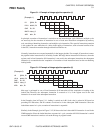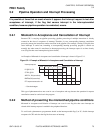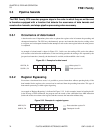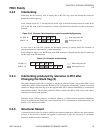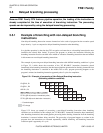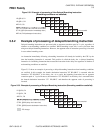
CM71-00105-1E FUJITSU MICROELECTRONICS LIMITED 73
FR81 Family
CHAPTER 5 PIPELINE OPERATION
5.2
5.2 Pipeline Operation and Interrupt Processing
It is possible at times that an event wherein it appears that interrupt request is lost after
acceptance of interrupt, if the flag that causes interrupt in the interrupt-enabled
condition, because pipeline operation is conducted, occurs.
5.2.1 Mismatch in Acceptance and Cancellation of Interrupt
Because CPU is carrying out pipeline processing, pipeline processing of multiple instructions is already
executed at the time of acceptance of interrupt. Therefore, in case corresponding interrupt cancellation
processing among the instructions under execution in the pipeline (For example, clearing of flag bits that
cause interrupt) is carried out, branching to corresponding interrupt processing program is carried out
normally but when control is transferred to interrupt processing, the interrupt request is at times already
over (Flag bits that cause interrupt having been cleared).
An Example of Mismatch in Acceptance and cancellation of interrupt is shown is Figure 5.2-1.
Figure 5.2-1 Example of Mismatch in Acceptance and Cancellation of interrupt
This type of phenomenon does not occur in case of exceptions and trap, because the operation for request
cancellation cannot be carried out in the program.
5.2.2 Method of preventing the mismatched pipeline conditions
Mismatch in Acceptance and Deletion of interrupt can occur in case flag bits that cause interrupt are
cleared while interrupt request is enabled in the peripheral functions.
To avoid such a phenomenon, programmers should set the interrupt enable flag (I) at "0", disable interrupt
acceptance in CPU and clear the flag bits that cause an interrupt.
IF ID EX MA WB
IF ID EX MA WB
IF ID --
--: Canceled stages
-- --
-- -- -- --
IF
IF ID EX MA WB
LD @R10, R1
Interrupt request
ADD R1, R3(cancelled)
BNE Te stOK(cancelled)
EIT sequence execution #1
ST R2, @R11
None None None None None None None
Generated Canceled









